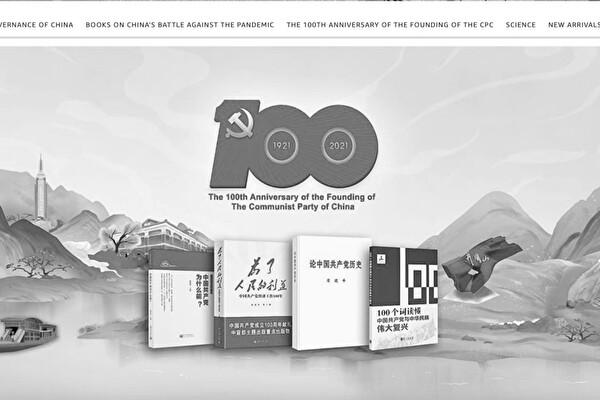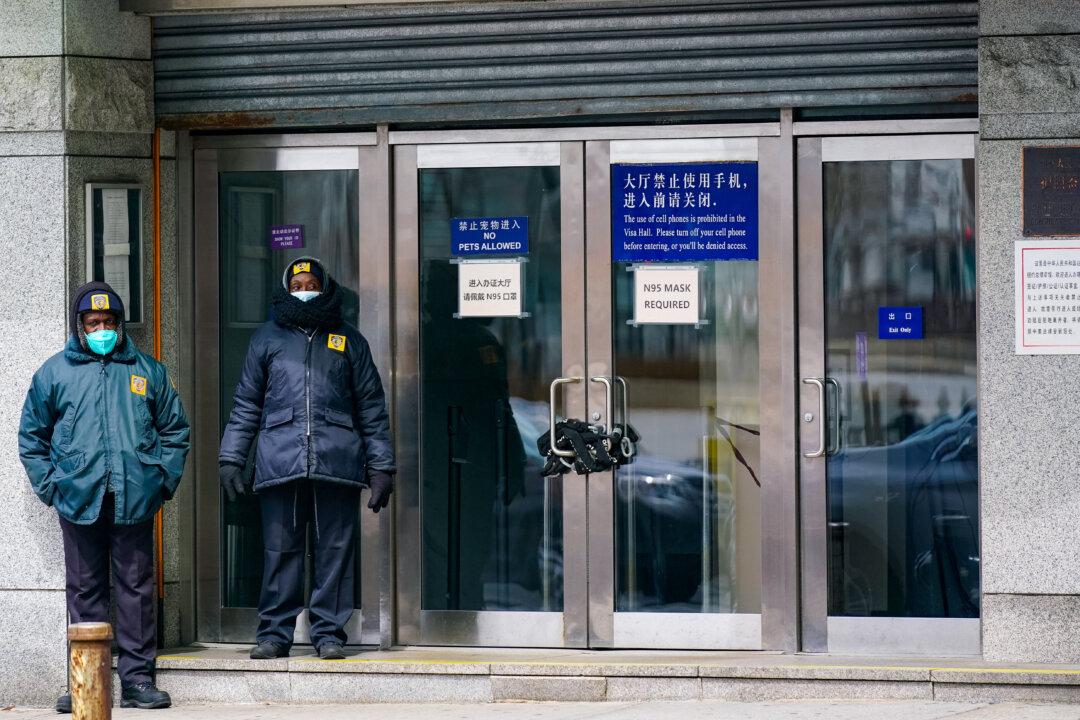She posted three screenshots from Amazon’s China Books store, which show the logo of the CCP’s 100th-anniversary celebration and Chinese leader Xi Jinping’s book “The Governance of China” in both Chinese and English languages.
Included in the “Books on China’s Battle against the Pandemic” section are Chinese and English versions of “Stories of Courage and Determination: Wuhan in Coronavirus Lockdown” and “2020, China’s Battle Against The Coronavirus: A Daily Log.” Both are about how the CCP and Xi have led the Chinese people to defeat the “grave test” of “the coronavirus outbreak.”
In another tweet, Ohlberg said, “The ‘Amazon China Bookstore project’ was selected as a ‘key national cultural export project’ in the past. I don’t see an ad disclaimer, but I'd really like to know how much money Amazon gets from the Chinese government for this.”
Amazon’s China Books Is a Key Project of the CCP
On Aug. 22, 2017, Jia Qiang, Secretary of the Party Committee of China International Book Trading Cooperation (CIBTC) wrote an article entitled “Using the Sharing Economy Model to Promote Chinese Culture To Go Global.” The article analyzed how to make full use of the ”cross-border e-commerce model” to drive the growth of cultural product exports.According to the article, in September 2011, CIBTC and Amazon launched the Amazon China Books project in Beijing, “Using Amazon’s mature online marketing platform, advanced technology, and global influence to promote Chinese publications into international mainstream marketing channels and realize global online sales of Chinese books.”
This strategy, to put it bluntly, uses foreign internet platforms to help the CCP do major international propaganda promotion in other countries.
In 2012 and 2015, the project was twice recognized as a key project by five CCP ministries: Commerce, Propaganda, Finance, Culture, and State Administration of Press, Publication, Radio, Film and Television.
The article further states that around the core mission and strategic thinking of accelerating “Chinese culture going abroad,” the company has made efforts to transform and upgrade its business model and has built a “cross-border e-commerce export platform for Chinese cultural products” by making full use of the sharing economy model.
48 Percent of Amazon’s Top 5,000 Products are from China
How many Chinese sellers are there on Amazon? EcomCrew, an online resource blog for e-commerce entrepreneurs, posted on June 28 that, “Selling on Amazon is HUGE in China. In fact, it is estimated that there are over 200,000 Chinese businesses currently selling on Amazon and this number is only expected to rise.”The article says the reason there are so many Chinese sellers on Amazon is because of “a love triangle: Amazon is in love with Chinese entrepreneurs, Chinese entrepreneurs are in love with Amazon, and the Chinese government is in love with Amazon.”
The article says, the revenues of the two largest sites in China, JD.com and Taobao, are $67 billion and $40 billion respectively. Their combined revenue is over 40 percent more than that of Amazon’s. So China is a country that is “comfortable with e-commerce,” and that is why the dream of “selling on Amazon” is huge for Chinese entrepreneurs.
Why does the Chinese Communist government love Amazon? According to the article, it’s because the CCP craves any cross-border e-commerce, which means exports, “something the Chinese government is desperate for, especially in the midst of a trade war with the U.S.”
The article also mentions that local Chinese governments have joined “Cross-border E-Commerce Experimental Zones.” For example, Zhejiang Province promotes cross-border e-commerce to local manufacturers and sellers, and claims to have more than 80,000 cross-border sellers.
The article says, while Amazon has never announced how many of its sellers are Chinese, using several methods to estimate, it can be determined that 48 percent of Amazon’s top 5000 products are from China, while 44 percent of sellers believed that 10 percent to 19.99 percent of their competitors were Chinese.
Cross-border E-commerce Is CCP’s ‘Cultural Highway to the Sea’
The “cross-border e-commerce model” is not unrelated to culture. On March 26, Chen Tianwen, Chief Architect of CIBTC, gave a speech at the Shenzhen Cross-Border E-Commerce Festival, comparing cross-border e-commerce to a “cultural highway to the sea.” He said that cross-border e-commerce is very significant for the CCP to construct its global cultural layout and narrative system.Chen also provided some data to support his statements.
“Amazon’s financial report shows that its total sales reached $475 billion in 2020, and the global third-party seller sales during Black Friday and Cyber Monday alone exceeded $4.8 billion. This has become a powerful engine to drive consumption. According to authoritative consulting institutions, global e-commerce sales will reach $6.5 trillion in 2023, and the huge e-commerce consumption market provides the best opportunity for Chinese cultural brands to go out and for overseas brands to come in.”
Chinese Publications Going Global is a ‘National Strategy’
The CCP’s three better-known major international propaganda programs are: the Confucius Institute system; cooperation with influential media around the world to buy space and use foreign media to “tell the China story well” in accordance with Xi; and leveraging the BRI economic power.However, the channel of books and publications is often overlooked.
In fact, as early as 1952, the CCP consciously implemented a strategy of localizing its major foreign publications around the world.
According to a 2018 article on the official CIBTC website, “Forty Years of Chinese Publications Going Global,” the company began participating in exhibitions in Bulgaria as early as 1952, and by 1957 had established external distribution networks in more than 50 countries.
The strategic importance of the CCP’s culture “going abroad“ is made even clearer in the 2019 article ”The Brilliant Journey of Chinese Publications Going Global” by He Yaomin, a member of the Standing Committee of the Party Committee and Vice President of Renmin University of China.
According to He, from the 1950s to the 1970s, the main task of international communication of Chinese publications was to “make China’s voice heard” and “oppose the Western camp.”
From the early 1960s to the late 1970s, the CCP faced a two-front war in the field of international public opinion and ideology. After China’s accession to the WTO at the end of 2001, “Chinese publications going global became a national strategy,” He said.
He explained that after the CCP’s 18th National Congress, Chinese publications’ main tasks were to “convey China’s position to the world, actively participate in international governance and propose Chinese solutions,” and “taking great strides towards the center of the world publishing stage.”
Amazon Promises to Make China Books ‘Bigger and Stronger’
According to the official CIBTC website, on April 23, 2018, Zhang Fuhai, director of the China Foreign Languages Publishing Administration, met with Jay Carney, senior vice president of Amazon, accompanied by Jia Qiang, secretary of the CIBTC Party Committee.Zhang Fuhai detailed the CCP BRI to Carney, who expressed his willingness to “help Chinese culture go global.”
Carney said that Amazon attaches great importance to the cooperation of the “China Books” project and would do its best to promote the bookstore to become “bigger and stronger.”
According to the report, “the two sides reached a consensus on the next step to increase publicity, expand cultural and creative products, strengthen data cooperation, and promote the transformation and upgrading of the project.”




